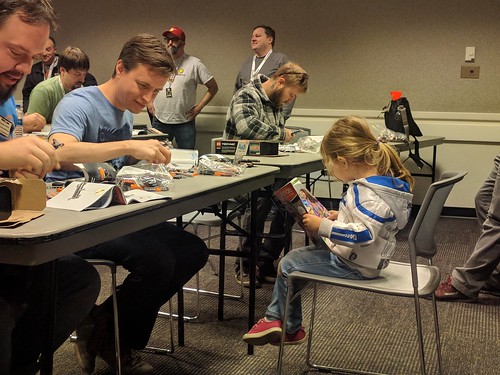Anging amongst 7.92 and 0.48 mgml). Firststrand cDNA was synthesized from 20 mg total
Anging amongst 7.92 and 0.48 mgml). Firststrand cDNA was synthesized from 20 mg total RNA, using the Superscript III indirect cDNA labeling technique (Invitrogen) with the following minor modifications to the manufacturers’ instructions. Briefly, the Qiagen PCR Purification kit was utilized to get rid of unincorporated aminoallyldUTP and cost-free amines with substitution of the Qiagensupplied buffers with phosphate wash (5 mM Phosphate buffer [K2HPO4KH2PO4O4] [pH 8.0], 80 D-3263 (hydrochloride) biological activity ethanol) and elution (four mM Phosphate buffer [K2HPO4KH2PO4O4] [pH 8.5]) buffers. The purified firststrand cDNAs have been subsequently labelled with the monoreactive Cy dye Nhydroxysuccinimide esters PubMed ID:https://www.ncbi.nlm.nih.gov/pubmed/21189263 Cy3 (handle, cDNA from strains sflCaEXP or sfl2CaEXP) and Cy5 (cDNA from strains sflCaEXPSFLHA3 or sfl2CaEXPSFL2HA3) (GE Healthcare) plus the uncoupled dye was removed making use of the normal Qiagen PCR purification kit protocol. The Cy3 and Cy5labeled cDNA lyophilized pellets were resuspended in 0 ml of DNasefree water then two.five ml and two.five ml of 0X blocking agent and 2X hybridization buffer (Agilent Technologies), respectively, have been added. The resulting samples had been mixed, incubated at 95uC in the course of three min and snap cooled on ice throughout min then hybridized to a Candida albicans expression array (Agilent Technologies) created such  that two nonoverlapping probe sets are targeting every of six,05 C. albicans ORFs for any total of five,744 probes, thereby enabling two independent measurements from the mRNA level for any offered gene (The EMBLEuropean Bioinformatics Institute ArrayExpress platform accession number: AMEXP242, http:ebi.ac.ukarrayexpressarraysAMEXP242).ChIPPCR assaysThirty cycles of PCR with five seconds at 95uC, five seconds at 50uC and 40 seconds at 70uC were performed on independently generated ChIP samples (Figures three and 9A) within a 50ml reaction volume with ml (5 ) of immunoprecipitated material. Primers were made to assay binding enrichment about about ChIPSeq peak summits (primer sequences are supplied in Table S9 in Text S). The URA3 and YAK ORFs have been employed as damaging controls.RNA isolation for microarray experimentsStrains sflCaEXP or sfl2CaEXP (handle strains, for subsequent Cy3 labeling) and sflCaEXPSFLHA3 or sfl2CaEXPSFL2HA3 (test strain, for subsequent Cy5labeling) (Table ) had been grown overnight in two ml YPD at 30uC. The following day, an aliquot on the overnight culture was used to inoculate 50 ml of Lee’s medium deprived of methionine and cysteine to a beginning OD600 of 0.three. This culture was grown for four hours at 37uC, cells were washed with diethyl pyrocarbonate (DEPC)treated water, collected by centrifugation and pellets were right away frozen and stored at 280uC till RNA isolation. Three independently obtained sets of cell cultures had been employed. RNA was isolated from frozen cell pellets employing the hotphenol system [8]. Briefly, cells have been resuspended in 375 ml TES buffer (0 mM Tris [pH 7.5], 0 mM EDTA, 0.5 SDS) at space temperature, soon after which 375 ml acid Phenol:Chloroform (five:, Amresco, Solon, OH) have been added. Samples were then incubated for hour at 65uC with vigorous vortexing in the course of 20 sec every single 0 min and subjected to centrifugation for 20 min at 4,000 rpm. The supernatants have been transferred to new tubes containing 750 ml acid Phenol:Chloroform (five:), mixed, and subjected to centrifugation at 4,000 rpm for 0 min. The aqueous phase was transferred to new tubes containing 750 ml Chloroform:Isoamyl alcohol (24:, Interchim, Montlucon, France), mixed and centrifuged at four,000 rpm during 0 min. RN.
that two nonoverlapping probe sets are targeting every of six,05 C. albicans ORFs for any total of five,744 probes, thereby enabling two independent measurements from the mRNA level for any offered gene (The EMBLEuropean Bioinformatics Institute ArrayExpress platform accession number: AMEXP242, http:ebi.ac.ukarrayexpressarraysAMEXP242).ChIPPCR assaysThirty cycles of PCR with five seconds at 95uC, five seconds at 50uC and 40 seconds at 70uC were performed on independently generated ChIP samples (Figures three and 9A) within a 50ml reaction volume with ml (5 ) of immunoprecipitated material. Primers were made to assay binding enrichment about about ChIPSeq peak summits (primer sequences are supplied in Table S9 in Text S). The URA3 and YAK ORFs have been employed as damaging controls.RNA isolation for microarray experimentsStrains sflCaEXP or sfl2CaEXP (handle strains, for subsequent Cy3 labeling) and sflCaEXPSFLHA3 or sfl2CaEXPSFL2HA3 (test strain, for subsequent Cy5labeling) (Table ) had been grown overnight in two ml YPD at 30uC. The following day, an aliquot on the overnight culture was used to inoculate 50 ml of Lee’s medium deprived of methionine and cysteine to a beginning OD600 of 0.three. This culture was grown for four hours at 37uC, cells were washed with diethyl pyrocarbonate (DEPC)treated water, collected by centrifugation and pellets were right away frozen and stored at 280uC till RNA isolation. Three independently obtained sets of cell cultures had been employed. RNA was isolated from frozen cell pellets employing the hotphenol system [8]. Briefly, cells have been resuspended in 375 ml TES buffer (0 mM Tris [pH 7.5], 0 mM EDTA, 0.5 SDS) at space temperature, soon after which 375 ml acid Phenol:Chloroform (five:, Amresco, Solon, OH) have been added. Samples were then incubated for hour at 65uC with vigorous vortexing in the course of 20 sec every single 0 min and subjected to centrifugation for 20 min at 4,000 rpm. The supernatants have been transferred to new tubes containing 750 ml acid Phenol:Chloroform (five:), mixed, and subjected to centrifugation at 4,000 rpm for 0 min. The aqueous phase was transferred to new tubes containing 750 ml Chloroform:Isoamyl alcohol (24:, Interchim, Montlucon, France), mixed and centrifuged at four,000 rpm during 0 min. RN.